Persephone is the Greek goddess of spring, nature, and flowers. She was abducted by the god of the underworld, Hades, because he desired her for a bride. It was while Persephone was abducted that winter occurred, for her mother Demeter refused to let anything grow until her daughter was found. Helios, the sun titan, had become distant and caused the world to become cold, as he sought for Persephone, to return her. Eventually, he found out what had happened and informed Demeter, who demanded that Hades return Persephone. However, it was law of the underworld that any person who ate any meal whilst in its depths would be required to stay in the underworld. And while she was there, Persephone ate four seeds of a pomegranate. Fortunately, Zeus took pity, and decreed that since it had only been four seeds, she would only have to stay in the underworld for four months of the year. These were the winter months, where all the green would follow Persephone to the underworld, as she took her place as queen of the underworld. When Persephone returns from the underworld, Helios and Demeter cease their mourning and searching, and the times of cold and hunger would leave once more.
Kijimba Kind
Kijimba Kind are spirits that hail from a variety of cultures. This is a collection of carvings installed in Alex Robertson in 2001 that portray these spirits, as a show of the diversity and similarities among the people in Pickering. Made from old telephone poles and power line poles, the trees that were felled for one purpose now find purpose in another means, with the intricate and symbolic carvings made by Dorsey James.
Kijimba Kind – Home Place
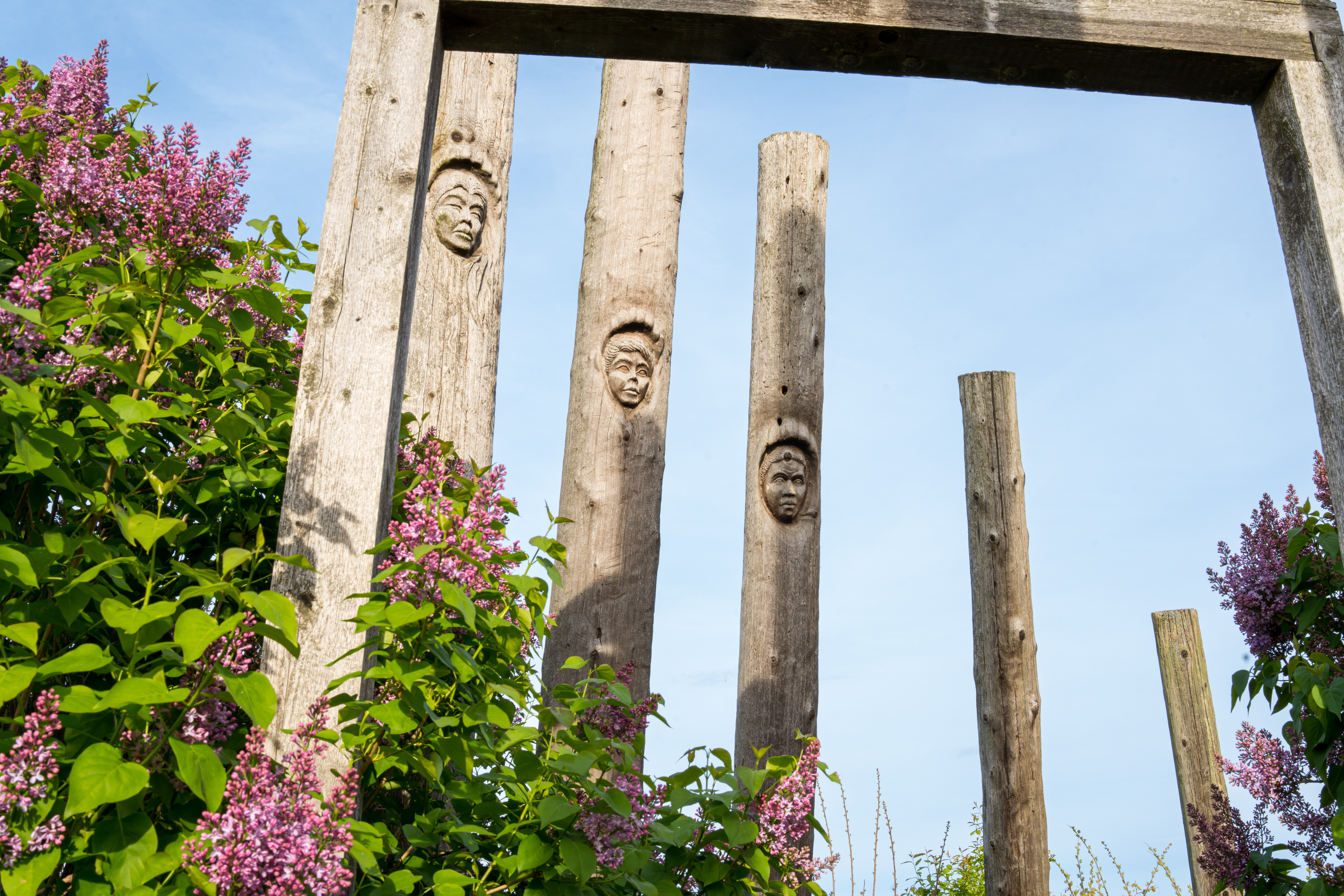
The sculpture “Kijimba Kind – Home Place” by Dorsey James located in Alex Robertson Park, Pickering
Kijimba Kind– Spring (Persephone)
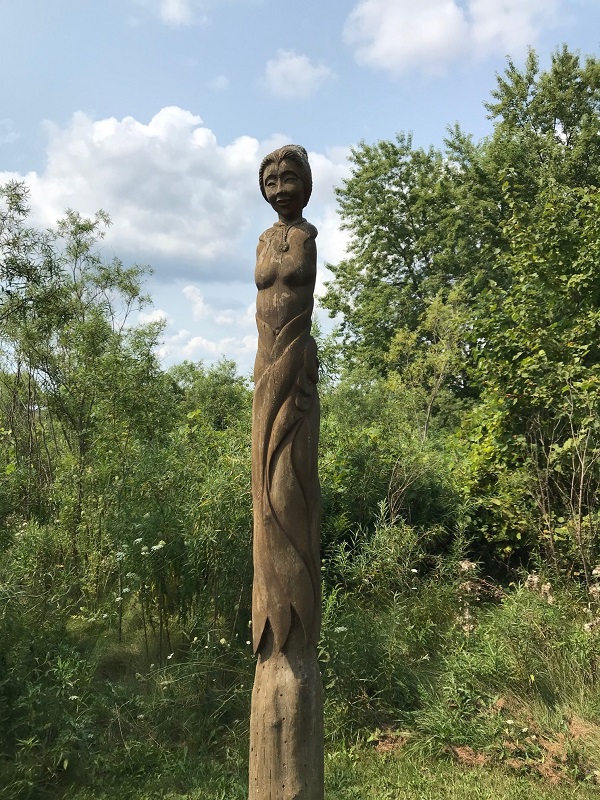
The sculpture “Kijimba Kind - Spring (Persephone)” by Dorsey James located in Alex Robertson Park, Pickering
Kijimba Kind - Eagle (Aquila)
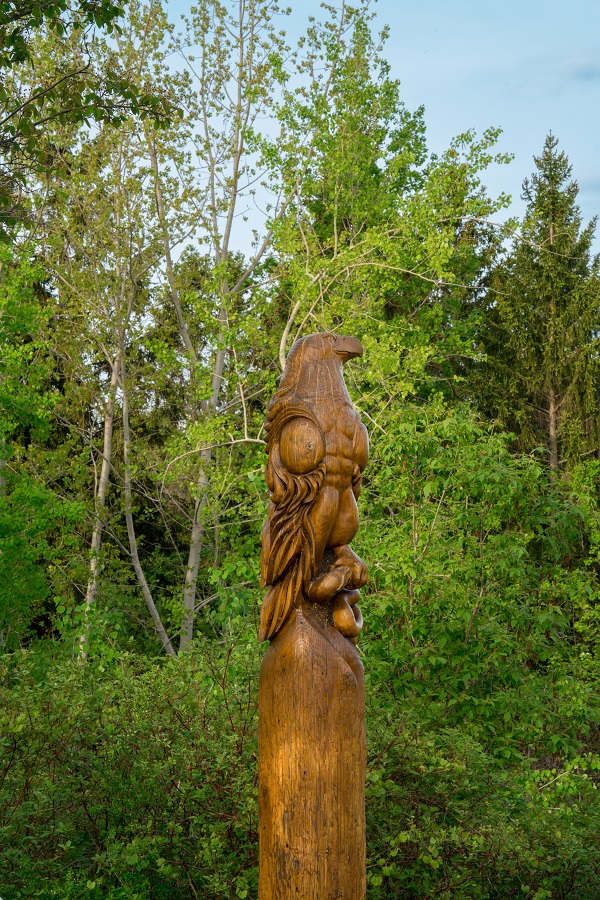
The sculpture “Kijimba Kind - Eagle (Aquila)” by Dorsey James located in Alex Robertson Park, Pickering
“Aquila” is the Latin word for ‘eagle,’ and there is a constellation named as such for this. In Greek mythology, Aetos Dios is the ‘Aquila’ that is said to have carried Zeus’s lightning bolts to his hand when he was angered. Another legend says that Aetos Dios had once been sent by Zeus to carry the gorgeous young mortal man Ganymede to Olympus, to become Zeus’s personal wine-bearer. An eagle is often used as a symbol of strength, prowess, and bravery. And snakes are typically used as symbols of wickedness, treachery, and cruelty. In this wooden depiction, the eagle has a snake caught and restrained in its talons. A very telling symbol for how it falls to the bold, the powerful, and the talented to remove corruption from the world, and let the rest of the world be at ease.
Kijimba Kind - The Crane (Sentinel)
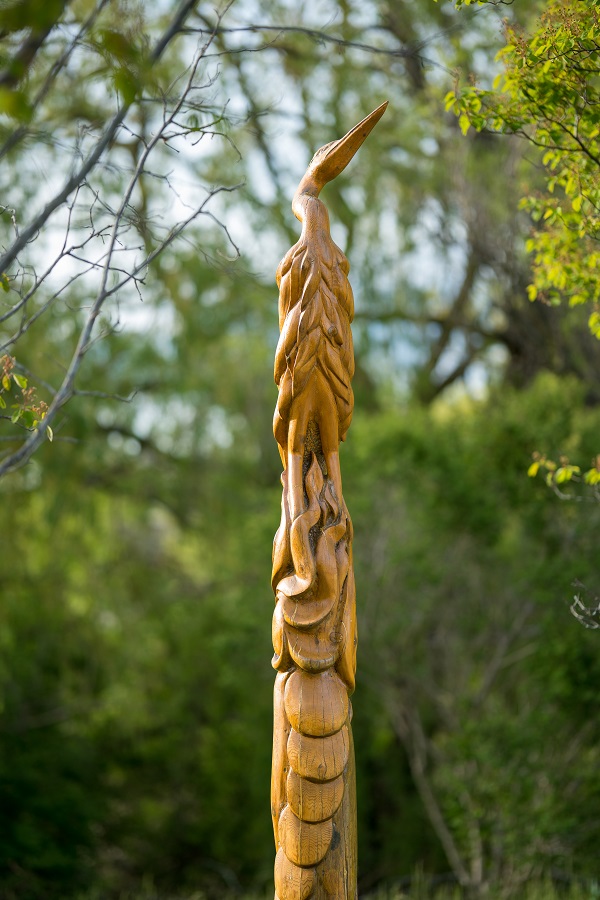
“Kijimba Kind - The Crane (Sentinel)” by Dorsey James located in Alex Robertson Park, Pickering
The Crane, alternatively titled “Sentinel,” is a carving of a crane that is meant to represent vigilance. It is said to balance a stone on its talons when it sleeps, and that when the slightest disturbance causes it to drop the stone, it wakes up. In some cultures, the crane represents life, and is the bringer of new infants to a household. The crane is sometimes also symbolic of death, as it is a towering predator in its natural habitat. The crane is also symbolic of majesty, grace, and patience. Much like the bird, this carving encourages us to be stand tall and proud. To be resilient in the face of whatever the world throws our way, and is meant as a source of pride that everyone can agree on.
Kijimba Kind - Owl (Hibou)
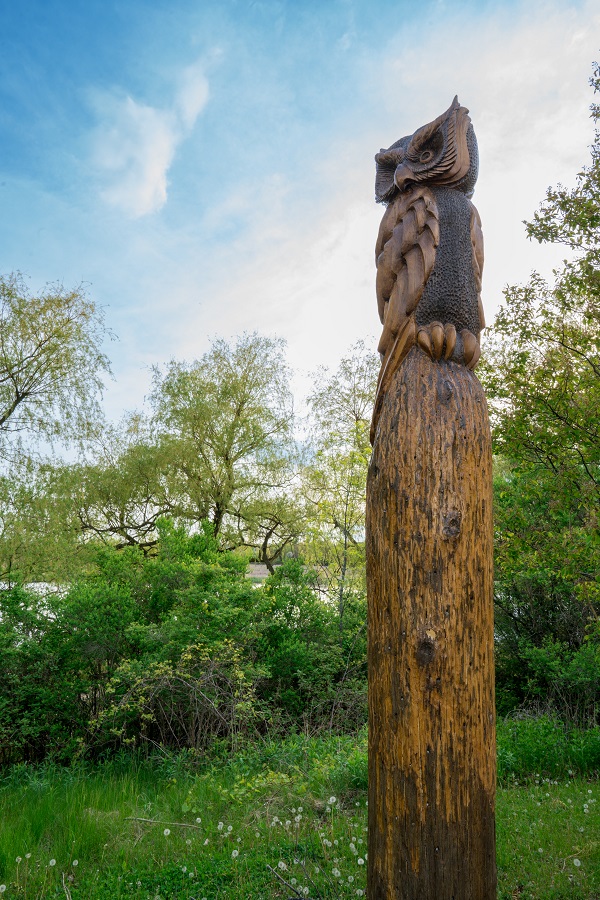
“Kijimba Kind - Owl (Hibou)” by Dorsey James located in Alex Robertson Park, Pickering
‘Hibou’ is French for ‘owl,’ specifically referring to those owls that have ear tufts on their heads, similar to that which are depicted in this wooden sculpture. Owls are regularly used in symbolism to represent wisdom, knowledge, and awareness, in a few different cultures, not limited to that of Indigenous Americans and the Greek and Roman mythos. This is most likely due to the somber, dignified sound of an owl’s hoot, and the combined features of both large eyes and a head that can rotate completely backwards, letting the owl see in all directions without having to adjust any other part of their body to do so. The owl depicted in this wooden carving is meant to symbolize the wisdom and awareness that we all must display, in order to avoid making mistakes, and to avoid unnecessary accidents that might hinder ourselves and others around us.
Kijimba Kind - Bridge Builder (Tji-Wara)
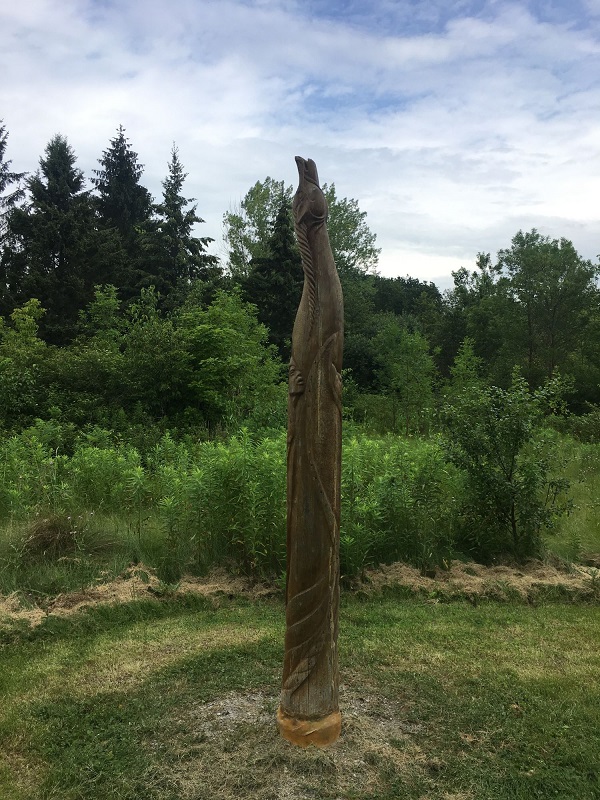
“Kijimba Kind - Bridge Builder (Tji-Wara))” by Dorsey James located in Alex Robertson Park, Pickering
The figure of Tji-Wara is an African equivalent to the Bible’s Moses, but with the added capability of shapeshifting. Also referred to as the ‘Bridge-Builder,’ she similarly was helping her people flee from a threat. When a gorge needed to be crossed, she changed into a tree to let her people use her to cross. When they were starving, she changed into an antelope so that her people could eat her in order to survive. To the Tji-Wara people, the antelope is an important figure in a different manner, as well. These people have a masquerade of sorts to celebrate the spirit that came to them – in the shape of an antelope – and taught their people how to farm. ‘Tji wara’ translates in their dialect to ‘work animal,’ further signifies this figure’s importance in their livelihoods.
Kijimba Kind - The Parson
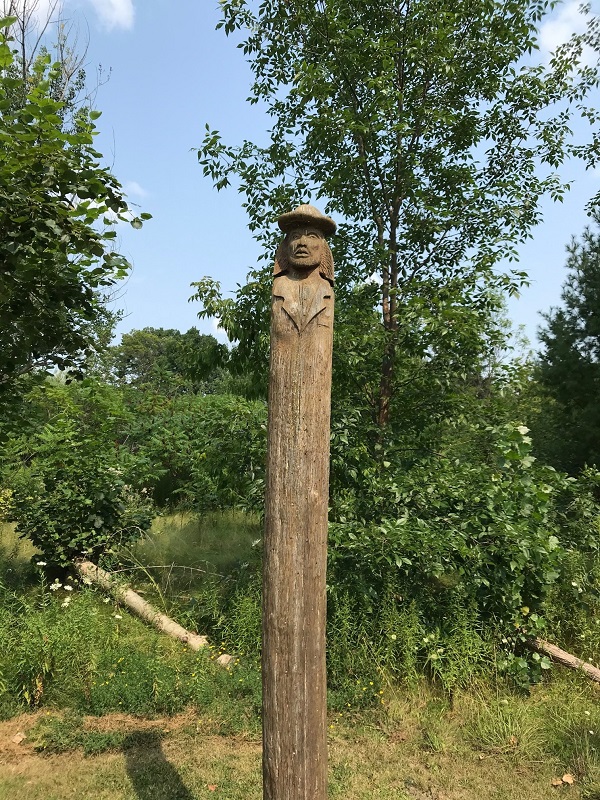
“Kijimba Kind - The Parson” by Dorsey James located in Alex Robertson Park, Pickering
This carving of the parson is a representation of just how much of a role religion and faith played in the efforts of people in the past, and how it shaped Pickering’s people as a whole, and continues to shape some today. A parson is an ordained Christian person in charge of a small area, most often being a parish. The term ‘parson’ used to be used to commonly refer to some Anglican clergy and, rarely, for ordained ministers in some churches. In the book by Geoffrey Chaucer, The Parson’s Tale, the parson was the one who succeeded where the friar and the monk failed. He gave to the needy, whilst living a life of poverty himself. He visited his fellow parishioners every day, even if the weather was foul. He didn’t regard sinners with hate, instead he taught them by example just what was right, and showed them the error of their ways. He is not haughty about his faith and bold in his actions, he is humble and meek, preferring a gentle approach to life and social gatherings. He is such a man devoted to truth, that he refuses to tell a fable, because he finds that using such stories gives false impressions of life. He was holy and virtuous in all of his ways.
Kijimba Kind - The Moirai
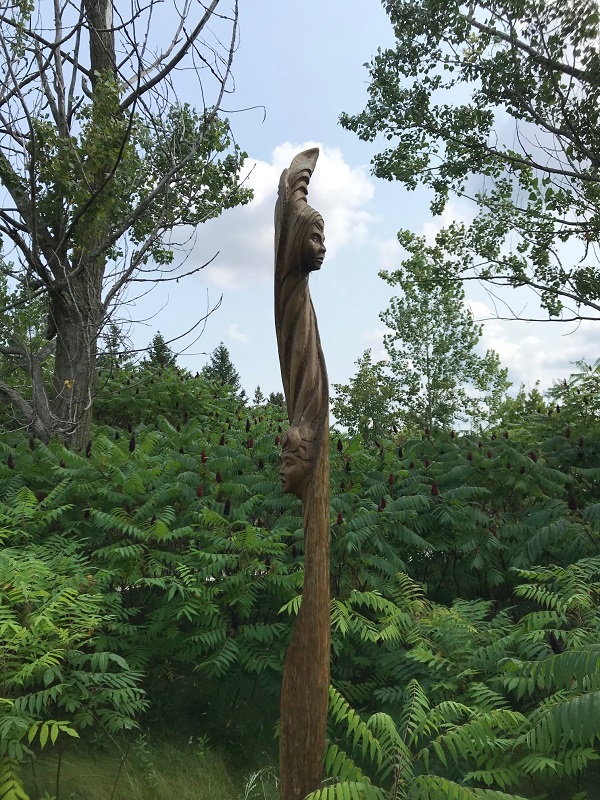
“Kijimba Kind - The Moirai” by Dorsey James located in Alex Robertson Park, Pickering
The Fates are three sisters in Greek mythology that are said to be the ones who weave the fabric of one’s life. Once they cut the thread, the person would pass away. This carving calls upon the beholder to consider their own life, and how they feel about their life so far. The Three Fates, also sometimes referred to as the Moirai, are sisters to not only each other, but to Thanatos (God of Death), Nemesis (Goddess of Retribution), and Hypnos (God of Sleep), and are daughters to Nyx (Goddess of Night). The Three Fates are: Clotho (Spinner), who weaves life into form; Lachesis (Alloter, or ‘drawer of lots’), who chooses how much of the thread is used on each person, measuring accordingly; and Atropos (“Inexorable,” “Inevitable,” or “the Unturning”), who severs the thread and chooses how each mortal is to die.
Kijimba Kind - Eden Seed
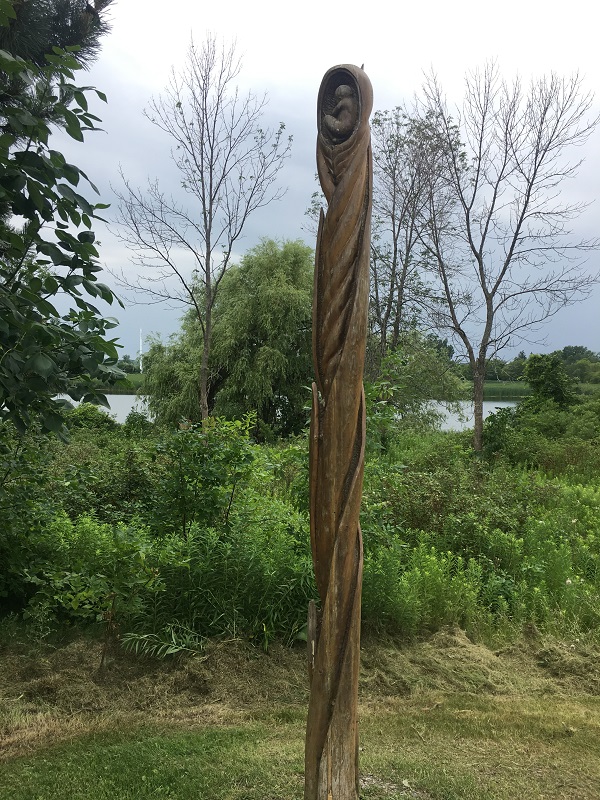
“Kijimba Kind - Eden Seed” by Dorsey James located in Alex Robertson Park, Pickering
Eden Seed depicts a plant growing to bear fruit, but this fruit in question has a human baby growing within it, sheltered and safe. The garden of Eden is a biblical location that humanity had originated from. In the Christian, Catholic, and Jewish beliefs, Eden is God’s personal garden, meant to be a perfect haven for all his creations to life in harmony. However, the first two humans -- Adam and Eve -- showed how disobedient, foolish, and easily corrupted they could be, and so God cast them out to fend for themselves in the world beyond, before stationing an angel to guard the entrance to Eden, to forbid humanity from returning. The wooden carving calls us to remember our roots; where we come from, and the way it shaped us. Like the garden of Eden, we all have to leave home at some point in our lives, to fend for ourselves in the harsh world outside of the nurturing household.
Kijimba Kind - Thor
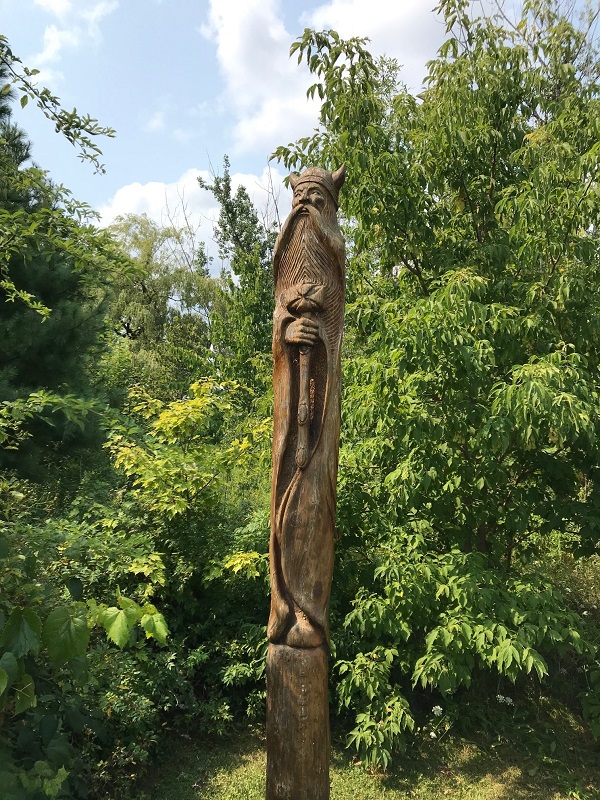
“Kijimba Kind - Thor” by Dorsey James located in Alex Robertson Park, Pickering
Thor is the Norse god of thunder, lightning, and fertility. His role in the Norse mythos was protecting mortals from chaos, destruction, and the forces of evil. He is also well-renowned for the hammer he wields, which is claimed to be the source of thunder; his hammer delivering terrible and powerful blows to all sources of danger to humanity. Though a Norse god, his presence is felt in a few different cultures, including English. Thursday, the fifth day of the week, is derived from the literal phrasing of “Thor’s day.” In this carving, Thor is depicted with a horned helmet, as many people typically believe when they think of Vikings. However, this is a misconception that stemmed from when people dug up the tomb of a dead Viking, and found a pair of drinking horns set on either side of his helmeted head.
About the Artist
Dorsey is a Pickering resident and member of PineRidge Arts Council. Now Canadian, he was born and raised in Philadelphia, Pennsylvania. After four years as a jet aircraft mechanic in the US Air Force, he immigrated to Toronto and eventually studied Visual Arts and Education at York University. His sculptures have been exhibited across Canada as well as in the United States and Germany. He lives with his family in Pickering, Ontario, continues to teach. He was awarded a commission by the Trillium Foundation for this waterfront sculpture entitled “Home Place”.
View the location of these pieces on the Public Art Map: Home Place; Spring (Persephone); Eagle (Aquila); Crane (Sentinel); Owl (Hibou); Bridge Builder (Tji-Wara); The Parson; The Moirai; Eden Seed; Thor.
Sign up for City updates
Subscribe to receive City of Pickering updates, news, public notices and more.
